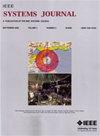Sum Rate Maximization Over Riemannian Manifolds for RIS-Assisted Coexistence of Radar and Communication Systems
IF 4.4
3区 计算机科学
Q1 COMPUTER SCIENCE, INFORMATION SYSTEMS
引用次数: 0
Abstract
Radar and communication coexistence (RCC) aims at improving the spectral efficiency of next generation wireless systems. One of the challenges facing RCC, however, is the mutual interference between the two coexisting subsystems. A reconfigurable intelligent surface (RIS) can thus be used to address such a challenge by optimizing its phase shifts along with the beamforming weights at the base station (BS). In this article, we aim to maximize the communication sum rate (SR), while limiting the interference toward the radar to a certain limit. Motivated by the unexplored fact that covariance matrices of RCC signals are Hermitian positive definite (HPD) and hence, can be represented over Riemannian manifolds (i.e., curved surfaces), the RCC SR maximization problem is reformulated as minimization of a Riemannian metric, which is the geodesic distance between the covariance matrices of the radar and the RIS-relayed signals. Such geometric reformulation paves the road for a雷达与通信系统ris辅助共存的黎曼流形和速率最大化
雷达与通信共存(RCC)旨在提高下一代无线系统的频谱效率。然而,RCC面临的挑战之一是两个共存子系统之间的相互干扰。因此,可重构智能表面(RIS)可以通过优化其相移以及基站(BS)的波束形成权重来解决这一挑战。在本文中,我们的目标是最大化通信和速率(SR),同时将对雷达的干扰限制在一定限度内。由于RCC信号的协方差矩阵是厄米正定的(HPD),因此可以在黎曼流形(即曲面)上表示,因此RCC SR最大化问题被重新表述为黎曼度量的最小化,黎曼度量是雷达和ris中继信号的协方差矩阵之间的测地线距离。这种几何重构为黎曼流形的低复杂度优化方法铺平了道路,该方法同时优化了BS和RIS处的波束形成权重和相移。仿真结果表明,该方案在满足雷达干扰约束的前提下,显著提高了通信SR。同样重要的是,与欧几里得空间上的最先进算法相比,所提出的黎曼流形优化方法的复杂性降低了。
本文章由计算机程序翻译,如有差异,请以英文原文为准。
求助全文
约1分钟内获得全文
求助全文
来源期刊

IEEE Systems Journal
工程技术-电信学
CiteScore
9.80
自引率
6.80%
发文量
572
审稿时长
4.9 months
期刊介绍:
This publication provides a systems-level, focused forum for application-oriented manuscripts that address complex systems and system-of-systems of national and global significance. It intends to encourage and facilitate cooperation and interaction among IEEE Societies with systems-level and systems engineering interest, and to attract non-IEEE contributors and readers from around the globe. Our IEEE Systems Council job is to address issues in new ways that are not solvable in the domains of the existing IEEE or other societies or global organizations. These problems do not fit within traditional hierarchical boundaries. For example, disaster response such as that triggered by Hurricane Katrina, tsunamis, or current volcanic eruptions is not solvable by pure engineering solutions. We need to think about changing and enlarging the paradigm to include systems issues.
 求助内容:
求助内容: 应助结果提醒方式:
应助结果提醒方式:


